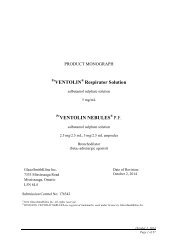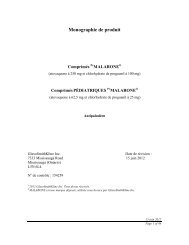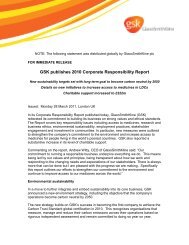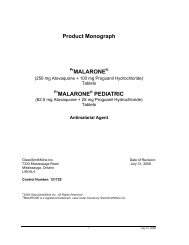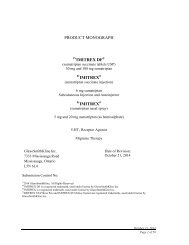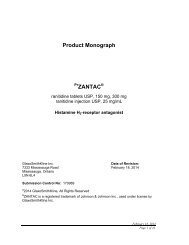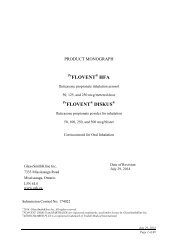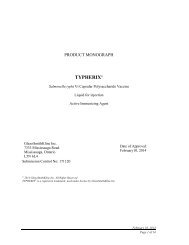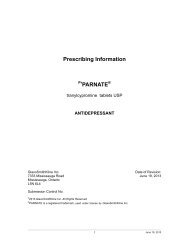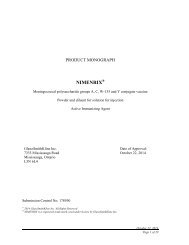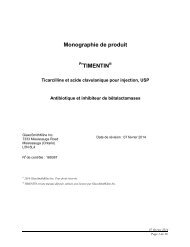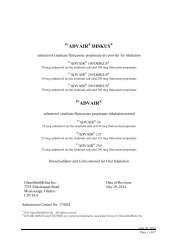VENTOLIN I.V. infusion solution - GlaxoSmithKline
VENTOLIN I.V. infusion solution - GlaxoSmithKline
VENTOLIN I.V. infusion solution - GlaxoSmithKline
You also want an ePaper? Increase the reach of your titles
YUMPU automatically turns print PDFs into web optimized ePapers that Google loves.
WARNINGS AND PRECAUTIONS<br />
General<br />
<strong>VENTOLIN</strong> ® I.V. <strong>infusion</strong> <strong>solution</strong> may be diluted with Water for Injection BP, Sodium<br />
Chloride Injection BP, Dextrose Injection BP, or Sodium Chloride and Dextrose Injection<br />
BP (see DOSAGE AND ADMINISTRATION). These are the only recommended<br />
diluents. Dextrose-containing <strong>solution</strong>s may not be suitable for patients with diabetes<br />
mellitus, due to the possible danger of glucose overload.<br />
The use of <strong>VENTOLIN</strong> ® <strong>infusion</strong> <strong>solution</strong> in the treatment of severe bronchospasm or<br />
status asthmaticus does not obviate the requirement for glucocorticoid steroid therapy as<br />
appropriate. When practicable, administration of oxygen, concurrently with<br />
<strong>VENTOLIN</strong> ® <strong>infusion</strong> <strong>solution</strong> is recommended, particularly when salbutamol is given<br />
by intravenous <strong>infusion</strong> to hypoxic patients.<br />
Cardiovascular<br />
In individual patients, any beta 2 -adrenergic agonist, including salbutamol, may have a<br />
clinically significant cardiac effect. Care should be taken with patients suffering from<br />
cardiovascular disorders, especially coronary insufficiency, cardiac arrhythmias and<br />
hypertension. Special care and supervision are required in patients with idiopathic<br />
hypertrophic subvalvular aortic stenosis, in whom an increase in the pressure gradient<br />
between the left ventricle and the aorta may occur, causing increased strain on the left<br />
ventricle.<br />
Fatalities have been reported following excessive use of inhaled sympathomimetic drugs<br />
in patients with asthma. The exact cause of death is unknown, but cardiac arrest<br />
following an unexpected development of a severe acute asthmatic crisis and subsequent<br />
hypoxia is suspected.<br />
Endocrine and Metabolism<br />
Metabolic Effects<br />
In common with other beta-adrenergic agents, salbutamol can induce reversible<br />
metabolic changes, such as potentially serious hypokalemia, particularly following<br />
nebulised or especially infused administration. Particular caution is advised in acute<br />
severe asthma since hypokalemia may be potentiated by concomitant treatment with<br />
xanthine derivatives, steroids and diuretics, and by hypoxia. Hypokalemia will increase<br />
the susceptibility of digitalis-treated patients to cardiac arrythmias. It is recommended<br />
that serum potassium levels be monitored in such situations.<br />
Large doses of intravenous salbutamol have been reported to aggravate pre-existing<br />
diabetes mellitus. The diabetic patient may be unable to compensate for the increased<br />
blood glucose levels and the development of ketoacidosis has been reported. Concurrent<br />
administration of corticosteroids can exaggerate this effect. Diabetic patients and those<br />
October 03, 2007<br />
Page 4 of 21



